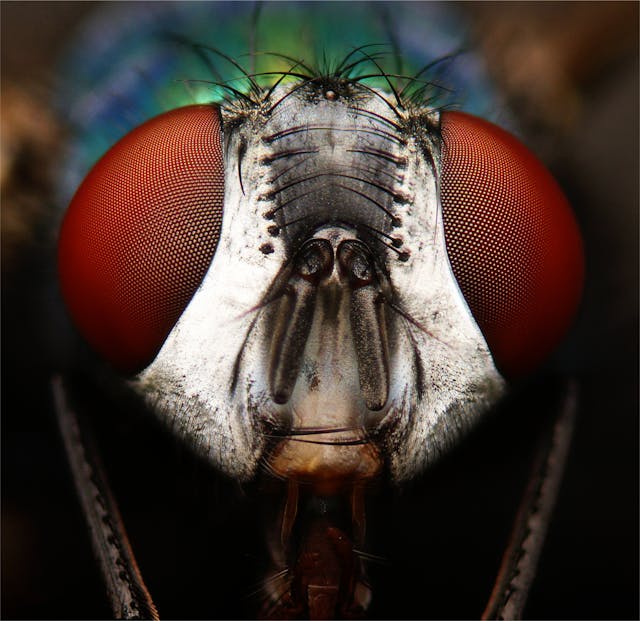
How do compound eyes work? Compound eyes work by having a large number of microscopic eyes that each have a lens and see an image, which then gets combined in the brain.
Most of the insects that have eyes have compound eyes. The only insects that don’t have compound eyes don’t really have eyes at all. A lot of insects that live in caves or underground don’t have eyes because there is no light for them to see with. These insects have a strong sense of smell and touch that they can use to navigate. An enormous number of insects have compound eyes, but they vary in the number of eyes that they have and also how they see the image. Dragonflies have the most compound eyes. They have roughly 28,000 lenses on each of their eyes.
Compound eyes are made up of hundreds or thousands of units called ommatidia. The word comes from Greek through Latin, and “omma” means eye. Each one of these ommatidia has a lens and can focus light and detect color. These ommatidia are like tubes. At the top end is a cornea, which is the transparent part that protects the eye and stops things from getting in. Then there is a simple lens that cannot move but focuses the light down the tube. The outside of the tube is made of cells that are stiff enough to keep their shape, and inside the tube are rhabdoms, which are light-sensitive rods that run the length of the tube. They are surrounded by pigments. When light enters the insect’s eye, it is roughly focused by the basic lens onto the rhabdom. This can detect the amount of light or the color. This information is then sent down the optic nerve to the brain, where it is assembled into a picture.
Compound eyes have some advantages, but they also have some disadvantages. Let’s look at the advantages first. Compound eyes are located on the sides of an insect’s head, but they are curved and usually span the front of the head to the back of the head. That gives insects an almost 360-degree field of vision, which is why you cannot sneak up on a fly. A lot of prey animals, such as cows, also have eyes in the sides of their heads and they have a wild field of vision, but they have to physically move their eyes to see different things. They can only ever be looking in one place at a time. Insects can see without moving their eyes or their heads, and light is entering their eyes from all directions, all the time. Insects also have an extremely high level of motion detection, which is much faster than ours. With our eyes, light enters through the front of the eye only. With compound eyes, light enters all of the ommatidia, and if there is light, they trigger and if there is no light, they don’t. This turning on and off creates a flicker whenever there is movement, and that enables faster reactions in insects. Bees react in 0.01s, while it takes us until 0.05s. A lot of insects use that to escape from predators, but some insects, such as dragonflies, use it to catch their prey. The compound eyes and the photoreceptor cells that are in them also allow insects to see ultraviolet light. This can help them find other insects to mate with, and help them navigate their environment. It can also help them find food because a lot of plants have markings and guides that are only visible under ultraviolet light. Insects also don’t see things upside down. The lenses in our eyes flip the image upside down on the back of our retina. Our brain then has to turn it back over. This every so slightly slows reaction time. Insects don’t have this.
Compound eyes do what they do very well, but they do have some disadvantages as well. The first is that they cannot be focused. We can see things far away or close up by using the muscles in our eyes to change the shape of the lens. Compound eyes don’t do that, and the insect has to move closer to the object. They also don’t have a very high resolution. We can see with a fair amount of detail, but images would appear very pixelated to insects. Although our eyes pale in comparison to birds such as buzzards. Insects had the choice of being able to see very clearly, or being able to see a lot of stuff at the same time, and being able to react quickly. Insects that could react quickly tended to outlive those that couldn’t, and compound eyes have continued. And this is what I learned today.
Sources
https://en.wikipedia.org/wiki/Compound_eye
https://www.nhm.ac.uk/discover/amazing-eyes-vision-champions.html
https://www.numberanalytics.com/blog/evolutionary-advantage-compound-eyes#google_vignette
https://en.wikipedia.org/wiki/Ommatidium
https://www.sciencing.com/insect-compound-eye-vs-human-eye-22657
Photo by Jason Reid: https://www.pexels.com/photo/close-up-macro-shot-of-a-housefly-s-red-eyes-33107085/
